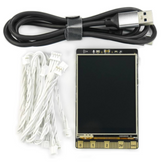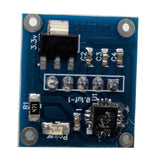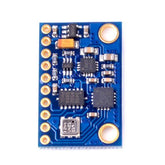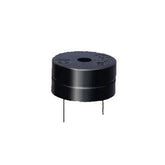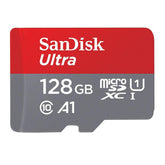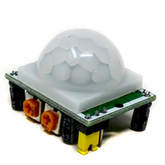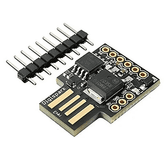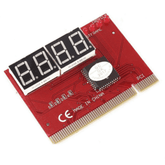Getting Started with UNIHIKER SBC: All-in-One Python Board
Summary
The world of single-board computers has evolved significantly over the past decade, with developers and educators constantly seeking more intuitive and feature-rich platforms for learning and prototyping.
The UNIHIKER SBC is a unique approach to educational computing that's changing how we think about programming hardware and developing IoT applications.
This comprehensive guide will walk you through everything you need to know about getting started with this innovative Python-focused board.

What Is UNIHIKER SBC Board?
UNIHIKER is a compact and feature-rich single-board computer (SBC) developed by DFRobot. It's a Debian-based Linux SBC that features a quad-core Arm Cortex A35 processor, an RISC-V MCU, and comes with a built-in 2.8-inch touchscreen display. The UNIHIKER series currently includes two models: UNIHIKER K10 and UNIHIKER M10.
The UNIHIKER stands out from traditional SBCs like the Raspberry Pi by offering an all-in-one, self-contained SBC "lab" experience.
This makes it particularly suitable for educational purposes, IoT applications, and STEM learning, especially for beginners looking to explore programming and hardware interaction.
Key Features of the UNIHIKER Board

The UNIHIKER Board features are carefully crafted to provide a comprehensive development experience without the complexity typically associated with embedded systems programming
Display and Interface
- 2.8-inch touchscreen display for intuitive interaction and data visualization
- Touch-enabled interface for direct interaction with projects
- Ability to display text, charts, graphs, and dynamic animations
Processing Power
- Main Processor: Quad-core ARM Cortex-A35 running at 1.5GHz
- Co-processor: RISC-V MCU for real-time operations
- RAM: 1GB DDR4 for smooth multitasking
- Storage: 32GB eMMC with microSD expansion support
Software Environment
- Operating System: Debian-based Linux
- Pre-installed Software: Jupyter Notebook, Python 3.x, PinPong library
- Programming Support: Multiple IDEs including VS Code, Thonny, and Mind+
Built-in Sensors
The board comes equipped with an impressive array of built-in sensors that enable immediate experimentation with Python coding on SBC platforms:
- Light sensor for ambient light detection
- Accelerometer and gyroscope for motion sensing
- Microphone for audio input and voice recognition projects
- Temperature sensor for environmental monitoring
Connectivity Options
- Wi-Fi for wireless internet connectivity
- Bluetooth for device communication
- Built-in co-processor for communication with various sensors and actuators
Expansion Capabilities
- I2C/UART/SPI interfaces for connecting external sensors and actuators
- Analog/digital input/output capabilities
- Gravity port compatibility for easy sensor connections
- Support for micro:bit breakout boards
UNIHIKER SBC board Specifications

Physical Layout and Connectivity
Primary Interfaces:
- USB Port: USB-C connector for power supply, data transfer, and programming connectivity
- MicroSD Card Slot: Expandable storage option for additional capacity beyond the built-in eMMC storage
- Dual I2C Ports: Two dedicated I2C interface connectors for connecting multiple sensors and peripherals simultaneously
Input/Output Capabilities
Digital and Analog I/O:
- Multiple I/O Pins: Several general-purpose input/output pins for connecting external components
- Flexible Pin Configuration: Pins can be configured for both digital and analog operations depending on project requirements
Built-in Sensor Array
Motion Sensing:
- Accelerometer: Integrated 3-axis accelerometer for detecting orientation, tilt, and acceleration changes
- Gyroscope: Built-in gyroscope for measuring rotational movement and angular velocity
Audio Output:
- Buzzer: Onboard buzzer for audio notifications, alarms, and simple sound generation
Board Design Features
Compact Form Factor:
- Optimized Layout: All components are efficiently arranged on a single PCB to maximize functionality while maintaining portability
- Component Integration: Critical sensors and interfaces are built directly into the board, reducing the need for external modules
Expansion Capabilities:
- Multiple Connection Points: Various connector types accommodate different sensor and actuator requirements
- Standardized Interfaces: Uses common communication protocols (I2C, digital I/O) for easy integration with existing components
Technical Architecture
Communication Protocols:
- I2C Communication: Dual I2C ports support multiple device connections with different addressing
- Digital Signal Processing: Dedicated I/O pins support both input sensing and output control
- Real-time Operations: Onboard sensors provide immediate data feedback for responsive applications
Power and Data Management:
- Single Cable Solution: USB-C port handles both power delivery and data communication
- Storage Expansion: MicroSD slot allows for additional storage capacity for data logging and larger applications
- Sensor Integration: Built-in accelerometer and gyroscope eliminate the need for external motion sensing modules
UNIHIKER vs Raspberry Pi
When evaluating the UNIHIKER SBC Board against the popular Raspberry Pi, it's essential to understand that these boards serve different purposes despite both being single-board computers.
The Raspberry Pi excels as a versatile, general-purpose computing platform with extensive GPIO options and community support, while UNIHIKER focuses specifically on educational applications and rapid prototyping with its integrated sensors and display.
This Raspberry Pi alternative for Python development offers a more streamlined, beginner-friendly approach that eliminates many setup complexities typically associated with embedded programming.
| Feature | UNIHIKER SBC | Raspberry Pi 4B |
|---|---|---|
| Built-in Display | 2.8" touchscreen included | External monitor required |
| Integrated Sensors | 6+ sensors (accelerometer, gyroscope, light, microphone) | No built-in sensors |
| Setup Time | Under 5 minutes, plug-and-play | 30+ minutes with OS installation |
| Programming Access | Web-based Jupyter Notebook, wireless | SSH, VNC, or desktop environment |
| Educational Focus | Purpose-built for Python programming for beginner's | General-purpose computer |
| GPIO Pins | Limited GPIO through expansion ports | 40-pin GPIO header |
| Price Point | ~$79 with integrated features | ~$35 base (additional costs for display/sensors) |
| Storage | 32GB eMMC + microSD expansion | microSD card required |
Setting Up Your UNIHIKER Board
Getting started with programming with UNIHIKER is remarkably straightforward, designed to eliminate common barriers that intimidate newcomers to embedded programming.
Initial Connection
- Connect via USB-C: Simply plug the UNIHIKER into your computer using the included USB-C cable
- Wait for Boot: The device boots automatically and creates a Wi-Fi hotspot
- Access Interface: Open your web browser and navigate to the provided IP address
- Start Programming: Jupyter Notebook opens immediately, ready for Python coding
Network Configuration
For permanent Wi-Fi connectivity:
- Access the device settings through the web interface
- Select your Wi-Fi network from the available options
- Enter your network credentials
- The device will automatically connect and be accessible from anywhere on your network
Development Environment Setup
The SBC with built-in display and sensors comes pre-configured with everything needed for Python programming for beginners:
- Jupyter Notebook for interactive development
- PinPong library for hardware control
- Example projects to demonstrate capabilities
- Documentation and tutorials accessible offline
First Program
Your first program can be as simple as displaying "Hello World" on the built-in screen:
python
from pinpong.board import Board
from pinpong.libs.dfrobot_display import DFRobot_Display
Board().begin()
display = DFRobot_Display()
display.clear()
display.print("Hello, UNIHIKER!")
This immediate feedback loop makes learning Python coding on SBC platforms incredibly engaging and rewarding.
Ideal Use Cases for UNIHIKER SBC Boards
The versatile nature of the UNIHIKER SBC Board makes it suitable for a wide range of applications, from educational settings to professional prototyping scenarios.
Educational Applications
Python programming for beginners becomes significantly more accessible with UNIHIKER's integrated approach:
- Classroom Teaching: The built-in display eliminates projection requirements
- Individual Learning: Students can work independently without additional hardware
- STEM Projects: Combining programming with sensor data creates engaging experiments
- Coding Bootcamps: Rapid setup allows more time for actual programming instruction
IoT Development Projects
As a dedicated IoT development board, UNIHIKER excels in connected device prototyping:
- Environmental Monitoring: Built-in sensors capture temperature, light, and motion data
- Smart Home Prototypes: Wi-Fi connectivity enables remote device control
- Data Logging: Local storage with cloud connectivity for long-term monitoring
- Sensor Networks: MQTT support enables professional IoT architectures
Rapid Prototyping
The combination of integrated sensors and immediate visual feedback makes UNIHIKER ideal for:
- Concept Validation: Quickly test ideas without hardware complexity
- User Interface Development: Touch display enables interactive prototypes
- Sensor Integration Testing: Validate sensor performance before full-scale development
- Algorithm Development: Real-time data visualization for algorithm tuning
Creative and Artistic Projects
The educational SBC platform supports creative applications through:
- Interactive Art Installations: Touch display and sensors create engaging experiences
- Music and Sound Projects: Built-in microphone and speaker enable audio applications
- Data Visualization: Real-time charts and graphs for scientific or artistic display
- Motion-Responsive Projects: Accelerometer and gyroscope enable gesture control
Professional Development
Even experienced developers find value in UNIHIKER for:
- Workshop Demonstrations: Eliminate setup time during technical presentations
- Client Prototypes: Quickly demonstrate concepts with professional appearance
- Team Collaboration: Web-based programming enables remote collaboration
- Testing and Validation: Integrated sensors reduce external dependency complexity
Conclusion
The UNIHIKER SBC represents a thoughtful evolution in educational computing, addressing many of the pain points that have historically made embedded programming intimidating for newcomers.
By integrating essential components like display, sensors, and wireless connectivity into a single, streamlined package, it removes barriers that often prevent people from exploring the exciting world of hardware programming.
While it may not replace traditional single-board computers for all applications, the UNIHIKER excels in its intended role as an educational platform and rapid prototyping tool.
Its emphasis on immediate gratification through visual feedback, combined with the power and flexibility of Python programming, creates an environment where learning becomes both engaging and productive.



